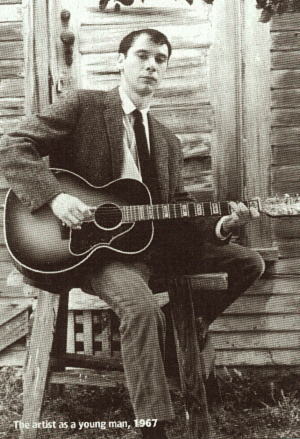|

John Fahey 1939年生於美国马里兰州的 Takoma Park 市, 自1959年推出首张大碟 “Blind Joe Death” 起, 一直从事音乐创作已近40年~ John Fahey 以 acoustic 结他为创作的工具, 致力开拓结他音乐的可能性, 与 Robbie Basho 及 Leo Kottke 两位同在自家厂牌 Takoma 的结他手平分秋色, 同被视为当代最出色的乡谣结他手~
然而, 这位天才横溢的音乐人, 晚年却在贫穷和疾病中度过~ 把罕有的珍藏唱片变卖, 甚至把自己赖以为生的结他典当以换取金钱过活, 都是 John Fahey 经常迫不得已所做的事~ 这位传奇音乐人最后在2001年一次手术后离世, 享年61岁~
One of acoustic music's true innovators and eccentrics, John Fahey was a crucial figure in expanding the boundaries of the acoustic guitar over the last few decades. His music was so eclectic that it's arguable whether he should be defined as a "folk" artist. In a career that saw him issue several dozen albums, he drew from blues, Native American music, Indian ragas, experimental dissonance, and pop. His good friend Dr. Demento has noted that Fahey "was the first to demonstrate that the finger-picking techniques of traditional country and blues steel-string guitar could be used to express a world of non-traditional musical ideas -- harmonies and melodies you'd associate with Bartok, Charles Ives, or maybe the music of India." The more meditative aspects of his work foreshadowed new age music, yet Fahey played with a fierce imagination and versatility that outshone any of the guitarists in that category. His idiosyncrasy may have limited him to a cult following, but it also ensured that his work continues to sound fresh.
Fahey was a colorful figure from the time he became an accomplished guitarist in his teens. Already a collector of rare early blues and country music, he made his first album in 1959, ascribing part of it to the pseudonymous "Blind Joe Death." Only 95 copies of the LP were pressed, making it a coveted collector's item today. (In the 1960s, Fahey would re-record the material for wider circulation.) In college, he wrote a thesis on Charley Patton (an exotic subject at the time). Yet Fahey did not perform publicly for money until the mid-'60s, after his third album.
Fahey's early albums for Takoma in the mid-'60s laid out much of the territory he would explore. His instrumentals, filtering numerous genres of music into his own style, evoked haunting and open spaces. At times they could be soothing and plaintive; at other times they were disquieting, even dissonant. The more experimental aspects of his material even foreshadowed psychedelia in their lengthy improvisations (some cuts lasted as long as 20 minutes), use of Indian modes, unpredictable stylistic shifts, and overall eerie strangeness. His persona as a weirdo of sorts was amplified by his bizarre and lengthy song titles and liner notes. He also employed odd guitar tunings that continue to exert an overlooked influence on contemporary musicians to this day.
Fahey remained consistently popular on a cult level through the mid-'80s. His most commercially successful efforts, oddly, were probably his Christmas albums, which are among the more interesting holiday records of any genre. For a time he ran the Takoma label, where he was instrumental in starting the career of Leo Kottke (who owes much of his stylistic inspiration to Fahey), as well as promoting lesser-known talents like Robbie Basho. He was a catalyst in other subtle ways, helping to form Canned Heat by introducing Al Wilson (who played on a Fahey album in 1965) to Bob Hite, and rediscovering Delta bluesman Bukka White with his friend Ed Denson.
Fahey sold Takoma to Chrysalis in the mid-'70s, but continued to record regularly, and also tour (though his live performances were erratic). In 1986, he contracted Epstein-Barr syndrome, a long-lasting viral infection that, combined with diabetes and other health problems, sapped his energy and resources. Although the Epstein-Barr virus was finally overcome, the mid-'90s found him living in poverty in Oregon, where he paid his rent by pawning his guitar and reselling rare classical records. The appearance of a major career retrospective on Rhino, Return of the Repressed, in 1994 boosted his profile to its highest level in years. In 1997, he returned to active recording with City of Refuge and was planning a Revenant definitive package of Charley Patton's work when he died following sextuple-bypass surgery at the age of 61. The Fahey discography is dauntingly large and diverse; the neophyte is advised to start with the two-disc Return of the Repressed, but those who wish to dig deeper will be very pleased with Takoma's extensive reissues, which started to appear in the late nineties.

On February 11, 2003, we'll release our late founder John Fahey's final
album, Red Cross Disciple of Christ Today. An intensely personal project for John which he completed a few months before his death and originally intended for release in 2001, Red Cross can be heard as Fahey coming full circle, reinvigorated, at peace with both past and present.
Includes spine-tingling interpretations of Irving Berlin's "Remember" and the Gershwins' "Summertime," alongside a number of stellar new Fahey originals. Featuring the acoustic fingerpicking of yore as well as some shimmering electric guitar vamps, Red Cross Disciple of Christ Today touches those peculiarly Faheyian regions in the heart and mind. A final, sparkling gem from a true American original.
Packaged in a special, limited-edition letterpressed chipboard jacket with an inspirational pamphlet nestled inside.
下边是音源~!
John Fahey - 2003 - Red Cross.zip (38.67 MB)
[ 本帖最后由 海洛因 于 2008-1-29 21:20 编辑 ] |
